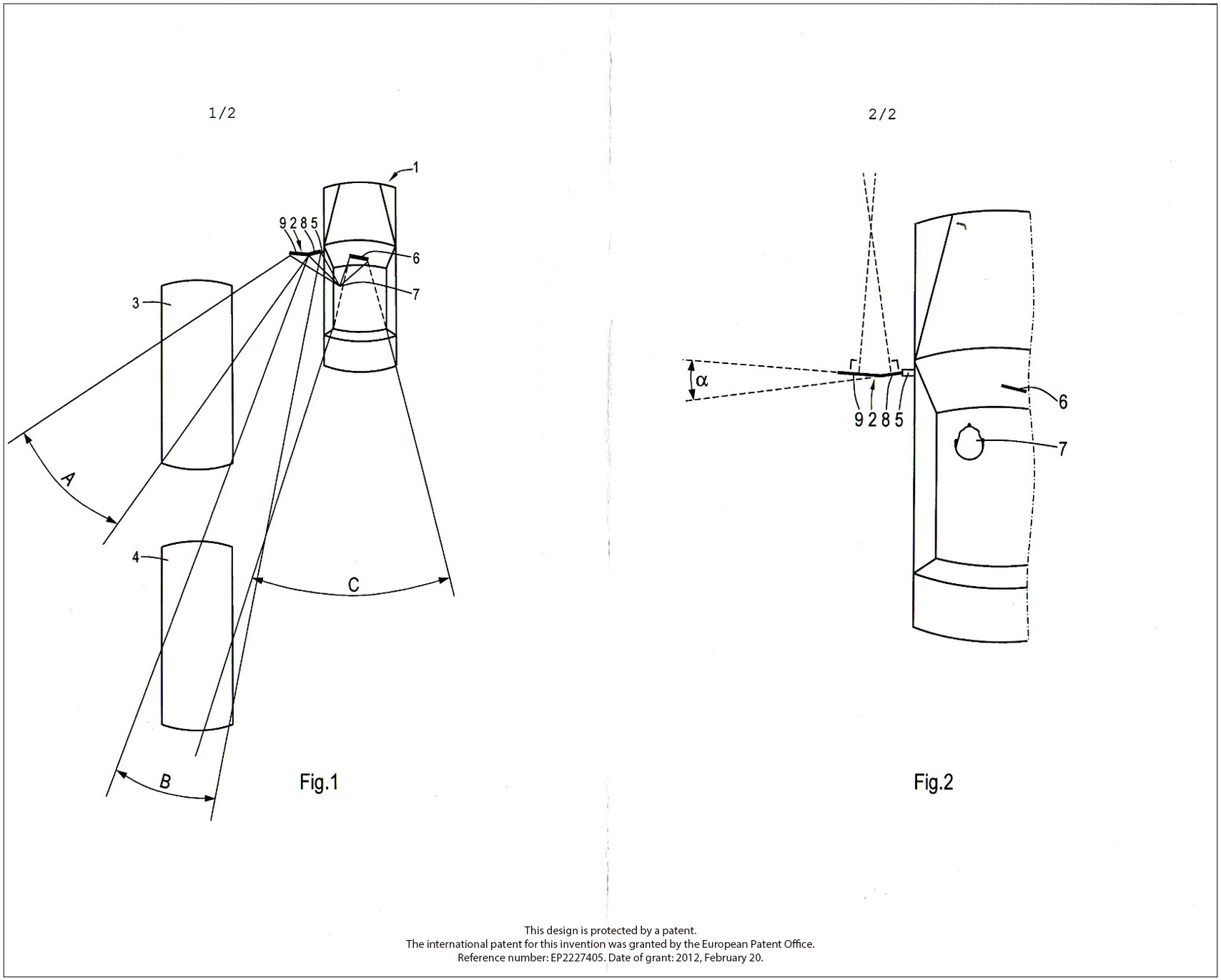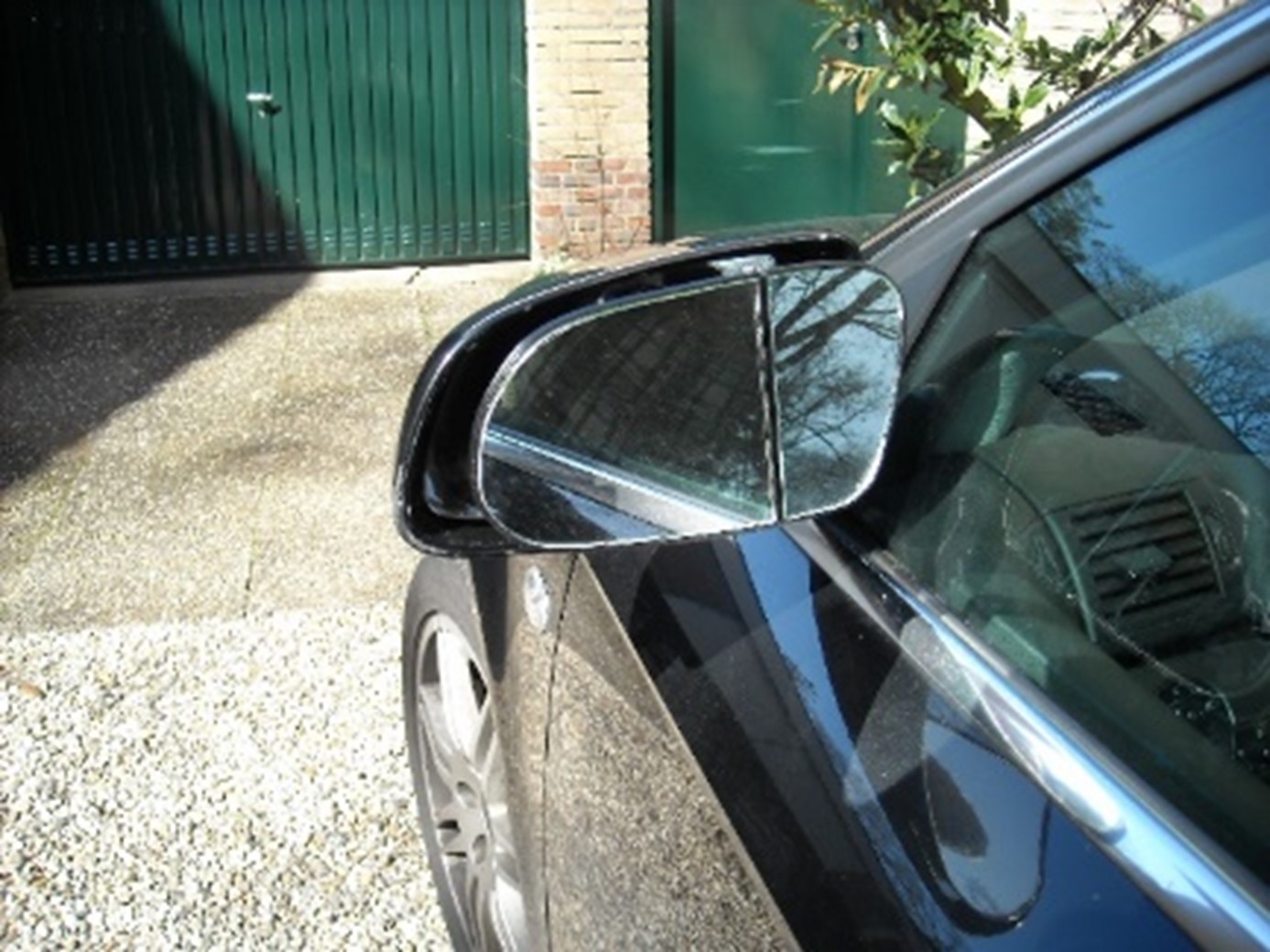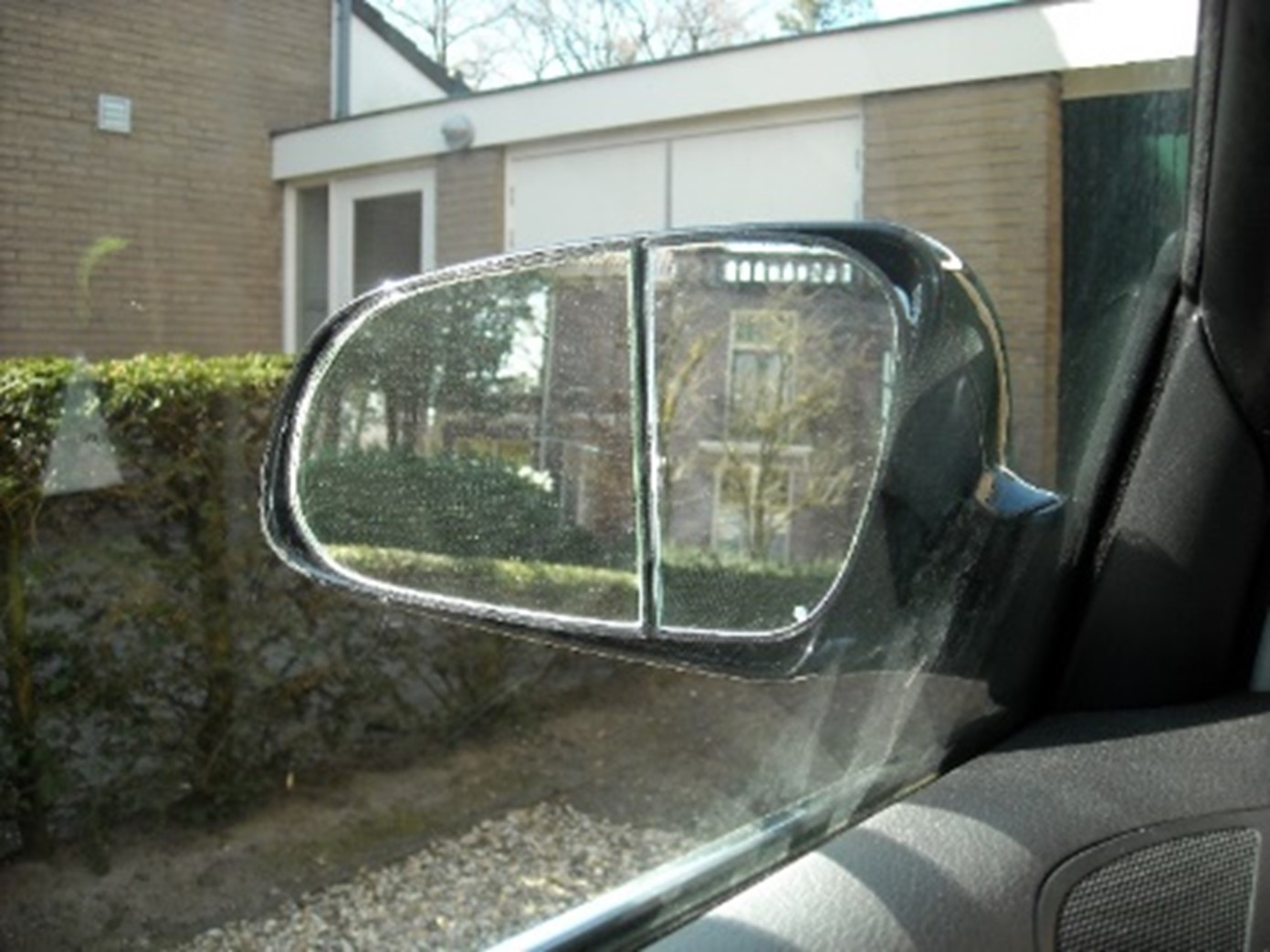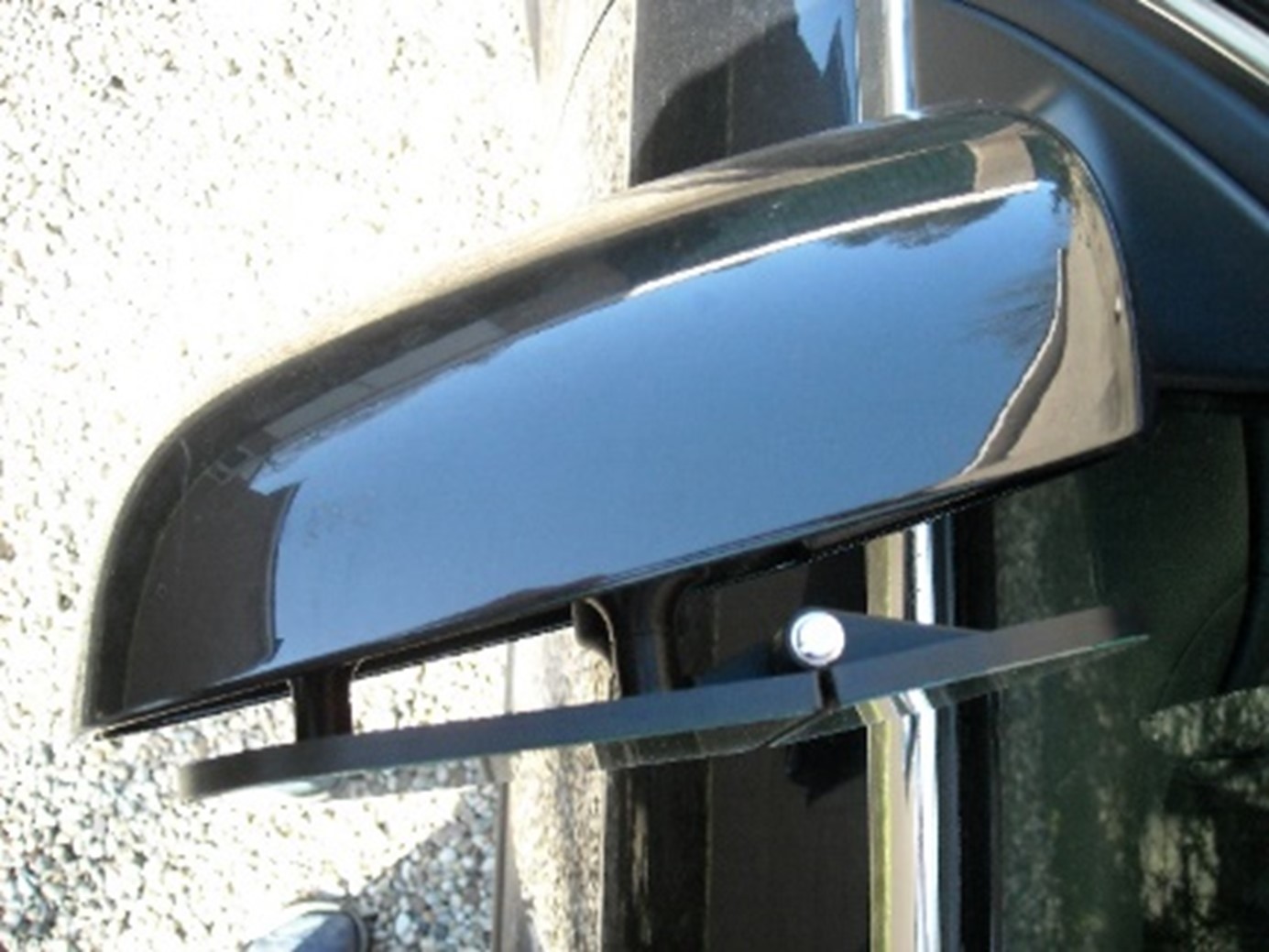Design for eliminating the blind spot of a rear view mirror completely
(Reference number of Patent: EP2227405. Granted: 2012, February 20)
Fewer accidents
Saves lives
Description of the design of the hinge-mirror
The goal of this exterior mirror design is not to reduce the blind spot as much as possible, but to eliminate it completely.
The application of this mirror is mainly for passenger cars and small commercial vehicles.
→ All experiments with the manufactured prototype confirm the disappearance of the blind spot: it no longer exists.
This elimination is achieved by replacing the conventional flat mirror by a mirror consisting of two separate flat parts which hinge with respect to each other about a vertical axis. Both parts are to be adjusted independently.
The mirror consists of a small proximal part and a large distal part, having a size ratio of approximately 1 : 2. Figure 2 shows that the angle between the parts is ± 4 – 12 °.
As shown in figure 1 the dimension of the proximal mirror part does not need to be large, because the overtaking car is still quite a distance from the side mirror, and therefore to be caught in a relatively narrow view range (fig. 1). In respect of the distal part the situation is completely different: the overtaking vehicle is now close to the mirror, and in fact more or less next to the vehicle which is overtaken. This requires a much broader view range: the dimension of that part has to be correspondingly wide.
The figures 1 and 2 show the position of the mirror parts and also demonstrate that due to the bipartite shaping the view range is substantially broadened. In particular the area next to the car which is overtaken remains visible over a much larger distance than with the conventional flat surface mirror.
The overtaking car actually remains clearly visible in the door mirror during the entire overtaking maneuver until it is completely next to the car that has been passed, and is visible at that moment without having to look over the shoulder so without the need to turn the neck.
This broadening of the view range is especially important by driving in the darkness: in the evening and night during the overtaking manoeuvre only the head-lights of the overtaking car are visible, and not the remaining parts of the car which is overtaking.
Adjustment of the mirror parts can be performed in a mechanical way or by small electric motors.
Other solutions to the blind spot problem
In order to eliminate the blind spot, conventional rear view mirrors of cars are frequently provided with a small convex portion distally. Sometimes a separate small-sized mirror, which forms an angle with the main mirror, is attached to the distal portion of the mirror. Unfortunately, these constructions do not solve the problem of the blind spot adequately: because the distance between the convex distal portion of the mirror and the overtaking vehicle is relatively short, the image of the vehicle in the mirror is large and it also runs through the mirror very rapidly. Another solution is tried in shaping the mirror surface in a convex manner; this however may create difficulties in the estimation of the distance between the mirror and the overtaking vehicle.
Quite a number of commercial vehicles are provided with two mirrors, placed above each other and with a different angle (often one has a convex shaped surface, and is directed a little downwards). For commercial vehicles this may be of (some) help to visualise the blind spot, especially because the distance from the mirror to the road surface is much larger. The disadvantage however is that overtaking cars cannot be kept in view in the horizontal plane all the way long.
In particular this phenomenon is important with respect to the position of the driver in the passenger car: he/she is positioned at a much lower level than the driver of a commercial vehicle, and a continuous monitoring of the image of an overtaking car in the mirror in a horizontal plane contributes a lot to the safety of driving; in fact it is a must.
In recent years there have been various developments in digital monitoring and control to tackle and/or solve the blind spot problem. In these mentioned inventions and developments – like those of mr. A. Herrmann from SMR ¹, of the MirrorCam in trucks, and also of the digital ‘driven’ mirrors in personnel cars – is claimed that the application of sophisticated digital monitoring, signaling and warning systems markedly reduces the blind spot.
¹ US 2020137853 (A1) – 2020-04-30. (Rear View Device Assemblies And Circuits).
Comments and objections to digital monitoring
Indeed are these digital detection and protection systems advantageous when approaching junctions and roudabouts, and in reversing.
However, for the decision of the car driver whether or not the adjacent lane of the road is sufficiently free to overtake safely, these digital monitors are not the most efficacious measure in solving the problem of the blind spot.
Why is that not the case?
Almost all of the present-day personnel cars – also the digitally armed – are still equipped with a rear view mirror having a small portion distally, and this distal part has a convex shaped surface. But this structure does not enable the driver in a sufficient way to define exactly the position of the overtaking car with regard to his/her own car, nor does it allow her/him to adequately estimate the proper speed of the overtaking vehicle.
The same applies to digital systems: concerning the estimation of the speed of the passing vehicle does a mirror with direct view and which does not distort the (mirror) image, provide more reliable information than one with a digital detection system.
Beyond that a mirror with direct vision shows an image of the overtaking car up to the moment that it is next to the car which is overtaken.
In a car with digital ‘driven’ rear view mirror is this quite different: in such a car, the image of the overtaking car itself does not provide the warning, but is evoked by an optical or an acoustic signal. Even a mirror with a build-in camera, is the detection of the overtaking car slightly behind compared to a mirror with ‘direct’ view.
Summary of the benefits of the design
With the described bipartite mirror the overtaking car remains visible continuously: before the car ´leaves´ the interior mirror it becomes visible in the proximal part of the bipartite rear view mirror, and before it ‘leaves’ this part, the image of the overtaking vehicle appears in the distal part. And finally, still visible in that distal part, it appears in the direct view field adjacent to the rear view mirror. Still the driver is looking at the mirror and not beyond.
Because of this situation, turning of the head sideways (looking over the shoulder) is no longer necessary to get the area next to the car in view. The advantage of no longer having to turn your head to assess whether the adjacent road section is clear for overtaking is obvious: the driver can thus constantly keep his eyes on the road ahead.
From the foregoing will be gathered that the described mirror contributes substantially to the driver’s decision-making process whether or not the part of the road next to and next back to the car is sufficiently free to start an overtaking manoeuvre in a safe way.
Another advantage of this mirror is that it can be mounted more closely to the vehicle body (due to the broadening of the view range of the distal part): this allows for a broader mirror, or positioning of the whole mirror more closely to the vehicle body and thus creating less sideward protrusion.
Conclusion
The essence of the new design of a rear view mirror is that the mirror surface is divided into two parts: a small proximal part and a large distal part, wherein the proximal part is angled with respect to the distal part. With this construction, the blind spot is not partially eliminated, but completely.
This mirror – hinge or articulating mirror – benefits the safety of overtaking in a number of ways:
(Strong points):
1. The car which overtakes remains visible continuously in –at least – one of the mirror parts; and before having ‘left’ the distal mirror part, it appears already in the view field adjacent to the lateral rim of the mirror. In this way the driver can ensure that the adjacent road section is sufficiently clear to initiate an overtaking maneuver.
Especially while driving in the evening and night is this broadening of the view range of importance.
2. Because of the fact that the overtaking car appears next to the rear view mirror while the drivers’ eyes are still pointing in the forward direction, turning the head sideways (i.e. looking over the shoulder) is no longer necessary.Therefore, the driver is allowed to keep his eyes permanently in the direction of the part of the road in front.
3. If sunbeams enter sideways the driver is easily blinded by the bright sunlight when he/she looks over the shoulder. Because this configuration avoids turning of the head sideways, blinding doesn’t occur.
Additional benefits:
4. In case of right-hand traffic, is it advantageous if the hinge-mirror is also mounted on the right-hand side of the car: a cyclist who wants to drive straight ahead is considerably more visible in that situation.
5. The portion of the mirror – the stem – that attaches it to the car, can be significantly smaller in size than with conventional mirrors. This means that the mirror protrudes considerably less.
6. This mirror is not very vulnerable:
– is more resistant to external violence due to its mechanical construction;
– the functioning of digitally controlled objects is more prone to malfunctions than mechanically driven ones.
7. This mechanical construction is cheaper compared to a digitally controlled one.
8. If for some reason turning the head sideways is not possible – like people who have problems turning the head sideways – this mirror offers a considerable advantage.
Weak points:
- This mirror construction requires two operating systems, one for each mirror part separately.
- Setting up the hinge mirror for the first time can be tricky.
- Because the proximal part of the mirror has a relatively small horizontal dimension, this can be experienced as ‘visual field narrowing’.
- When reversing, the field of view in the hinge mirror is somewhat restricted due to the smaller proximal mirror portion. This can be experienced as a limitation of sight.
- When it rains, the mirror fogs up; heating is then necessary.
Finally:
This design is protected by a patent.
The international patent for his invention was granted by the European Patent Office.
Reference number: EP2227405. Date of grant: 2012, February 15.
Technical drawings


Get in touch
Are you interrested in this design please contact us.
Contact Form


